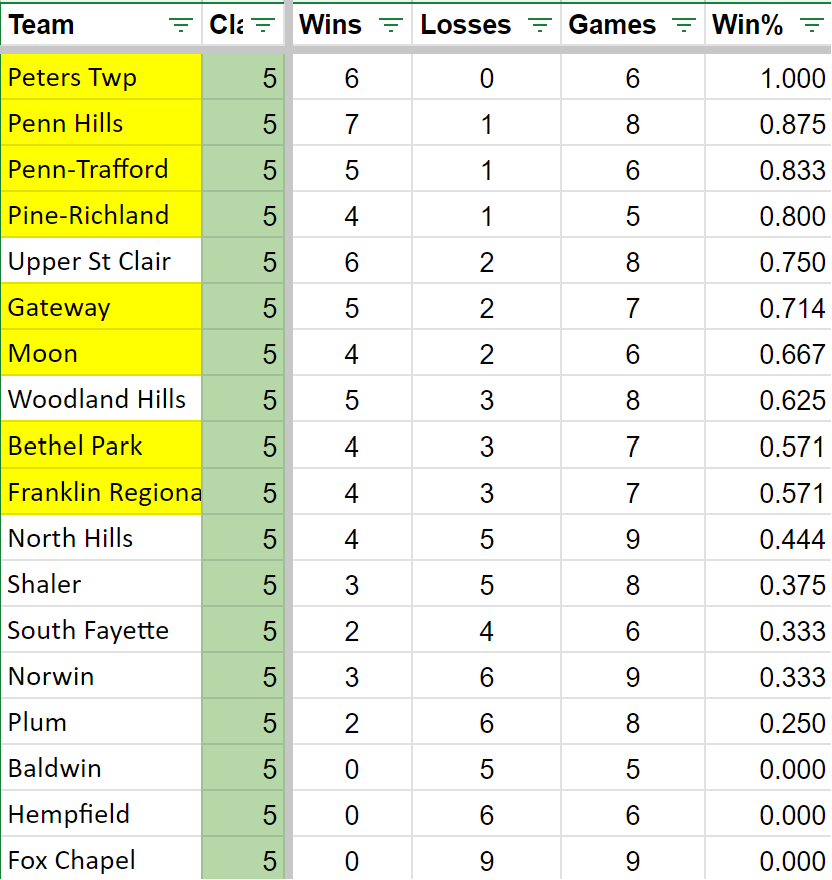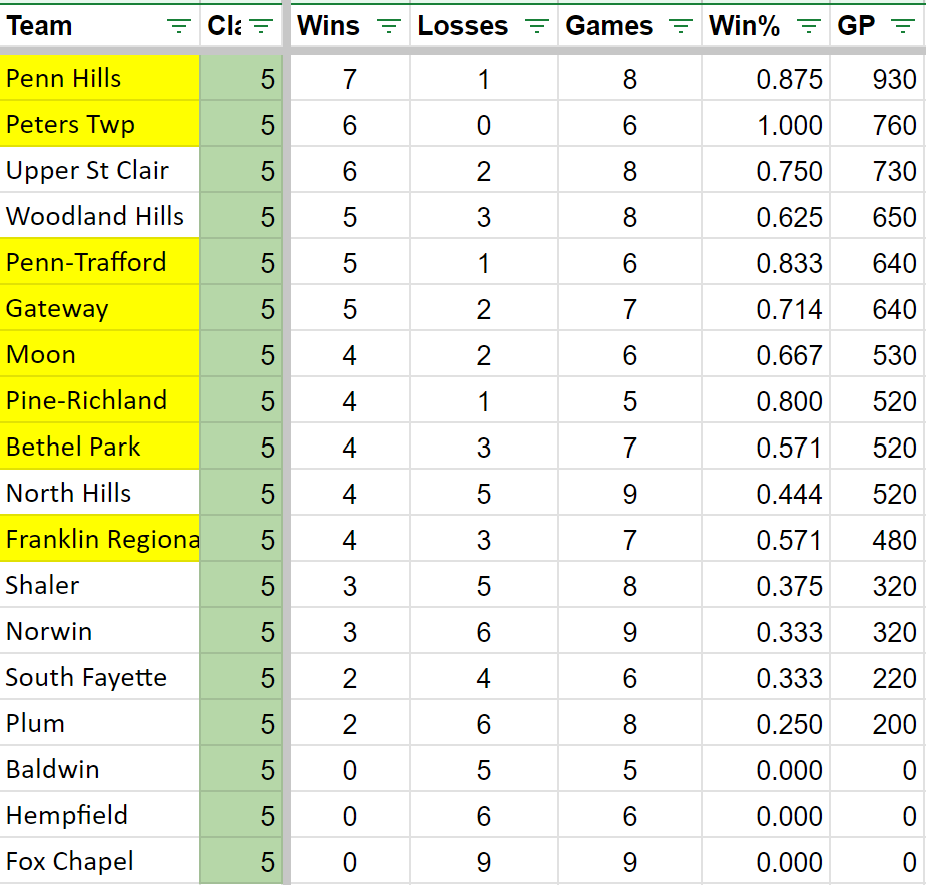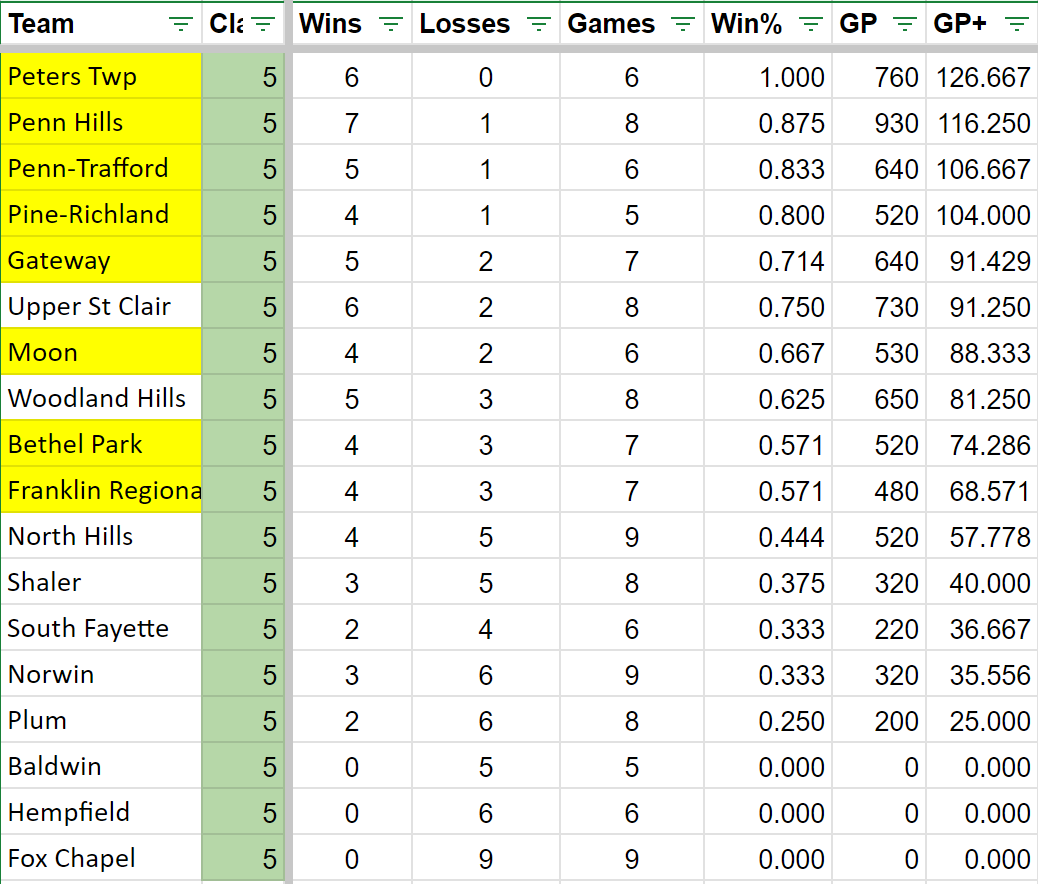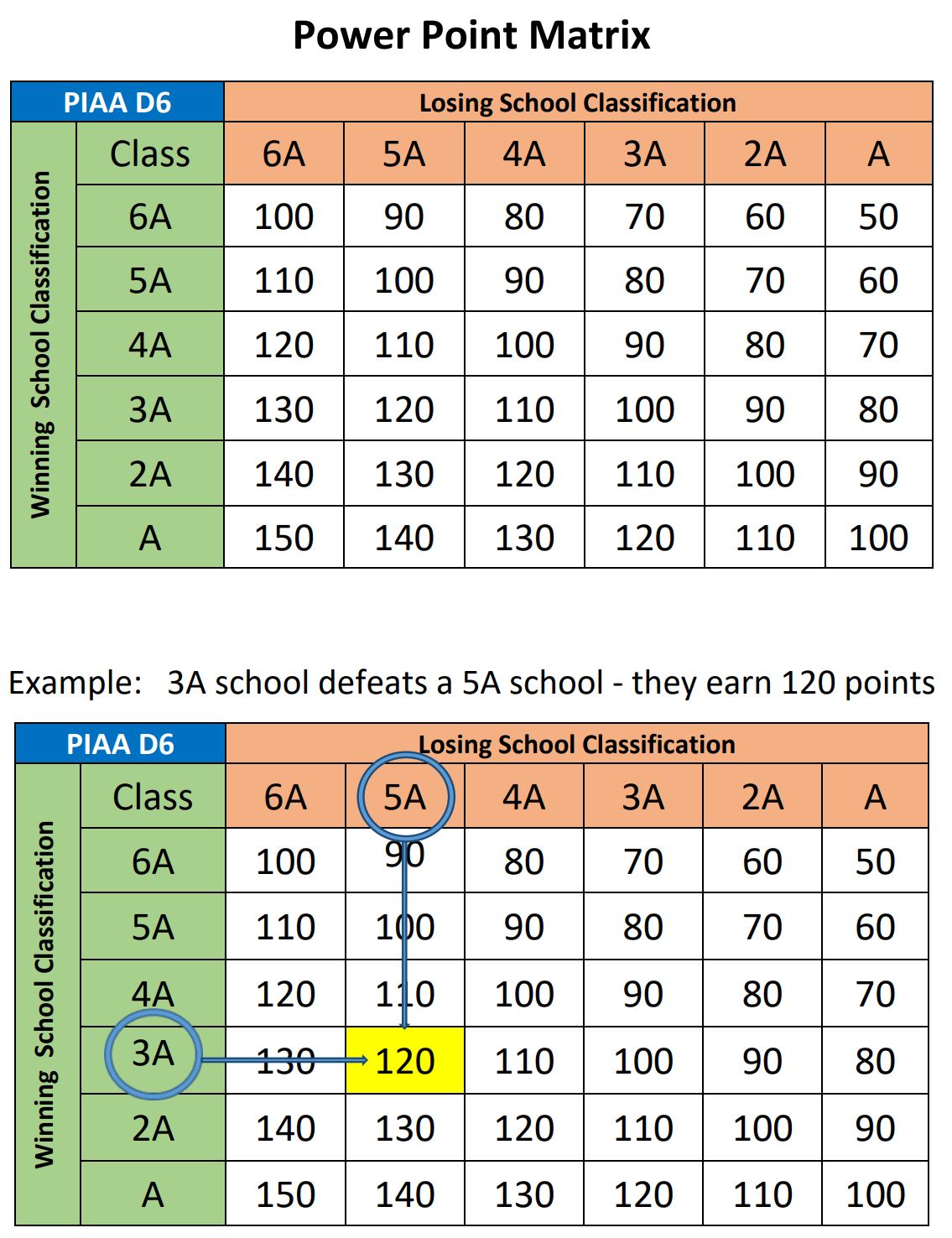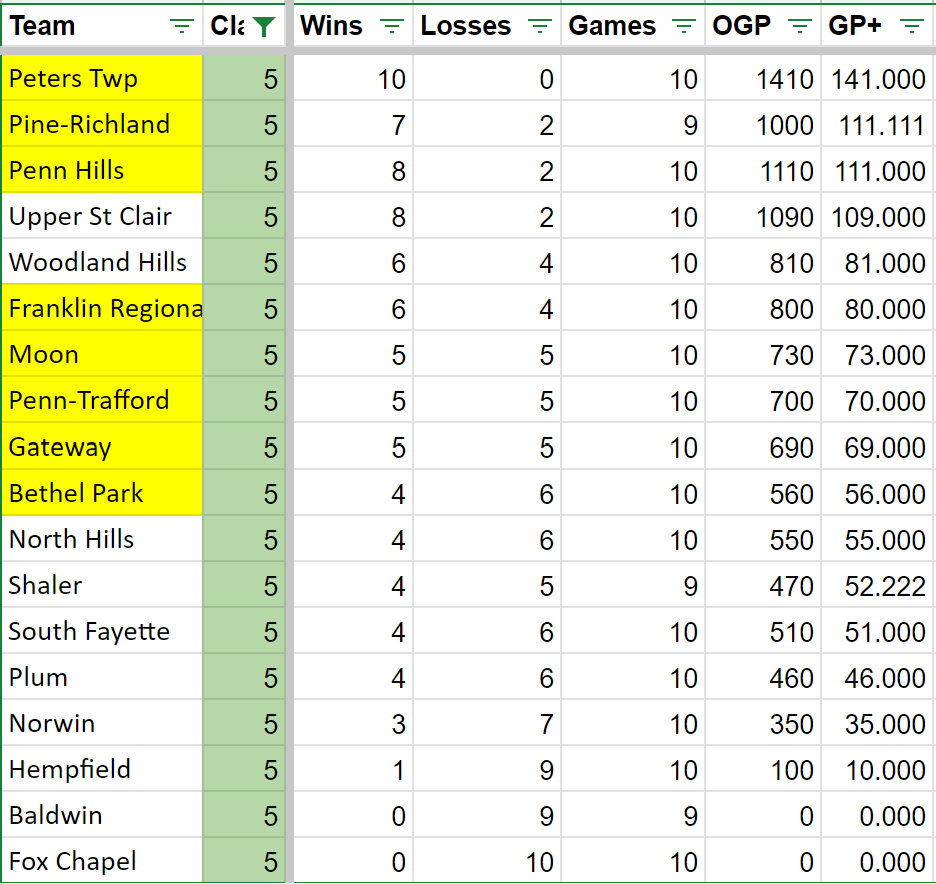On Friday night the WPIAL regular season came to a close. There was a lot of confusion over how the playoff situation for 5A shook out. Entering Week 9, Peters Twp, Bethel Park, Gateway, and Penn Hills had clinched playoff spots. Based on Friday’s results and the current way the WPIAL determines playoff teams, the other four spots went to Pine-Richland, Moon, Penn-Trafford, and Franklin Regional. Franklin Regional edged Woodland Hills for the final spot by 2 tiebreaker points. Upper St Clair, despite finishing 8-2 overall, missed out on the postseason for the first time since 1999 because they finished 4th in their conference. I will summarize how it all went down and propose some solutions for WPIAL to consider in the future to potentially remedy the situation.
How it Started: Six Classifications
When the PIAA made the change to six classifications in 2016, the WPIAL saw its top classifications thinned out. In 2014-15, there were 25 WPIAL teams in Quad-A. With the move to six classes, there were initially 14 teams in 6A and 18 teams in 5A. As districts in Eastern Pennsylvania grew over time, the 6A classification shrunk to 9 teams in 2018-19, 8 in 2020-21, and just 5 teams this cycle. The amount of WPIAL 5A teams has stayed relatively consistent. After the initial cycle with 18 teams, there were 24 WPIAL 5A teams in 2018-19, then back to 18 teams for the last two cycles. In the early cycles of the six classification era, the WPIAL tried to stack schedules with as many conference games as possible, opting for larger conferences. The initial 5A alignment had two conferences of 9 teams each. The 4A and 3A alignments were similar. The WPIAL heard significant feedback regarding extended travel times, declining attendance, and losing historical rivalry games due to the large conferences. To counteract this, in 2020, the WPIAL opted for an alignment of more conferences with fewer teams. This meant that the 18 5A teams were distributed into 3 conferences of 6 teams rather than 2 sections of 9 teams.
How it Started: The PIAA Makes a Change
At the beginning of the six classification era, the WPIAL Champion entered the state bracket at the quarterfinals. This meant that the WPIAL only had enough time in the schedule for three weeks of playoffs so only 8 teams qualified. This changed in 2018 when the WPIAL had 24 teams in 5A. The champion was advanced forward in the State playoffs and got to enter in the semifinals. This gave the WPIAL an extra week for the playoffs and they took 16 5A teams into the playoffs in order to have a full bracket. In addition to conference alignment changes, in 2020 the WPIAL also decided to shrink the 5A playoff field to 12 teams and give out 4 first round byes. With 18 teams, the WPIAL Champion still entered the State bracket in the semifinals. Then came the 2022 realignment. Despite the WPIAL still having 18 5A teams, the PIAA moved their champion back to enter in the quarterfinals instead of the semis as they had the prior cycle. (If you want to put on a tinfoil hat, you could theorize the PIAA moved the WPIAL Champion back because the WPIAL had claimed the last two State titles.)
With the WPIAL Champion being moved back to entering the state bracket in the quarterfinals, there was one less week available for playoff games. This limited the WPIAL 5A playoff field to just 8 teams. The WPIAL kept their distribution of the 18 teams spread into 3 conferences of 6 teams.
How it Works: Qualifying for the 5A Playoffs
Since the 1970s, the WPIAL has assigned playoff qualification based on order of finish within conferences. Last cycle, when 12 5A teams qualified for the playoffs, it was an easy route as the top four teams from each conference made the playoffs. When the PIAA moved the WPIAL Champion back in the state playoffs, the WPIAL kept the same alignment of 3 conferences with 6 teams each. However, with only 8 playoff teams, the WPIAL defined qualifiers as:
- The top two teams from each conference qualify for the playoffs
- Two of the three 3rd place teams earn Wild Cards based on the following formula
- Record in conference games
- Gardner Points earned in conference games
- Tiebreaker Points earned in conference games
Across the entire WPIAL, non-conference games do not count towards playoff qualification. In 5A, with 6 teams in each conference, that means that only half of a team’s schedule (5 of 10 games) counts towards playoff qualification. Gardner Points are earned based on the number of wins of the teams you defeated. A team earns 10 Gardner Points for each conference win of the conference opponents they defeated. Tiebreaker Points are based on the margin of victory or defeat, up to +10 or -10 for conference games only. It is important to note that only third place teams are eligible for the Wild Card.
What Just Happened
Peters Twp ran through their schedule this season and enters the playoffs as the only undefeated team in 5A. They easily handled all of their Allegheny Six Conference opponents. Behind the Indians, there was a 3-way tie for second place. Moon, Bethel Park, and Upper St Clair all finished 3-2 in conference play. The three teams all lost to Peters Township and all beat South Fayette and Baldwin. Head-to-head, they were split as Bethel Park beat Upper St Clair, Moon beat Bethel Park, and Upper St Clair topped Moon in double overtime. With the three teams tied in conference record, splitting head-to-head and tied with 40 Gardner Points, it was broken by Tiebreaker Points. Moon had the edge with a +17 mark, ahead of Bethel Park’s +12 and Upper St Clair’s -1. With Moon winning the tiebreaker for 2nd place and earning a playoff spot, the system then reverted to head-to-head to place Bethel Park 3rd and Upper St. Clair 4th. This meant that Bethel Park, who was 4-6 overall, finished ahead of 8-2 Upper St. Clair in the conference standings.
In the Big East Conference, Gateway cruised to the conference title. Penn-Trafford defeated Franklin Regional in the final week of the season to finish second. Franklin Regional finished third with a 3-2 record, 30 Gardner Points, and +8 in Tiebreaker Points. In the Northeast Conference, Penn Hills held on to beat Woodland Hills 26-21 to win the conference title. Woodland Hills had a go-ahead touchdown on 4th and goal from the 15 called back on a penalty with a minute left in the game. Pine-Richland defeated North Hills to finish 2nd in the conference, dropping Woodland Hills to third. Woody High finished with a 3-2 conference record, 30 Gardner Points, and +6 in Tiebreaker Points.
Determining the Wild Card
As per the WPIAL qualification procedures, two of the three third place teams earn Wild Cards. The three third place teams were Bethel Park, Franklin Regional, and Woodland Hills. All three finished 3-2 in conference play. The next level of tiebreakers is Gardner Points. Bethel Park had 40 while Franklin Regional and Woodland Hills had 30. Bethel Park’s points came from wins over Baldwin (0), South Fayette (1 win = 10 points), and Upper St Clair (3 wins = 30 points). This gave Bethel Park one of the two Wild Card spots. The final spot came down to tiebreaker points between Franklin Regional and Woodland Hills. Franklin Regional entered Week 9 with +18 tiebreaker points and Woodland Hills entered with +11 tiebreaker points. Franklin Regional lost 27-14 to Penn-Trafford, a defeat by more than 10 points decreasing their tiebreaker points by 10 to +8. Woodland Hills lost 26-21 to Penn Hills, the 5-point loss decreasing their tiebreaker points to +6. Therefore, Franklin Regional earned the last Wild Card by just 2 tiebreaker points. (In an odd twist of fate, if Woodland Hills had kicked a field goal on 4th and goal instead of going for the touchdown, they would have still lost the game but would have made the playoffs by edging out Franklin Regional in tiebreaker points +9 to +8. Of course, in the moment they had no way of knowing the score of the FR game and that a field goal would’ve sent them through. They had to play for the win which would’ve automatically qualified them for the playoffs.)
The Debate
Now that you have a full understanding of how we got here, the crux of the debate is this: Upper St Clair (8-2 overall) and Woodland Hills (6-4 overall) missed the playoffs while three teams .500 or below made the postseason (Moon and Penn-Trafford are 5-5, Bethel Park is 4-6). While Upper St Clair finished 4th in their conference and were ineligible for the Wild Card, they also had better tiebreakers than Franklin Regional who earned the final Wild Card. Remember that Franklin Regional was 3-2 in conference with 30 Gardner Points. Upper St Clair, while finishing 4th in the Allegheny Six, was also 3-2 in conference play with 40 Gardner Points. To be clear, those four teams that made the playoffs all earned their spots based on the WPIAL’s qualification procedures. The following commentary should not be seen as trying to take anything away from them. My intent is to present other ideas or options that could be considered for future changes to the WPIAL’s tiebreaking procedures.
Potential Solutions
Obviously, this year is over and done with. The playoff fields are set and nothing can change that. But since this will be a realignment year and the WPIAL will have an opportunity to shake up classifications this winter, it is worth considering some changes (between minor and major) that could make playoff qualification more equitable.
Allow Multiple Teams from One Conference to get the Wild Card
This is the simplest and easiest fix. The WPIAL is stuck in the “two of three third place teams get a wild card” mentality, eliminating any team that finishes below third. However, if three teams tie for a conference title, the WPIAL procedures say that they will all be named co-champions. But if three teams finish tied for second place, one of them is not eligible for the Wild Card. If more than one team per conference could earn a Wild Card, the 4th place Upper St Clair team would have been compared against Franklin Regional and Woodland Hills for the final playoff spot (and would have earned the spot on Gardner Points).
Let the WPIAL Steering Committee Select Playoff Qualifiers
This happened during the 2020 COVID season and there was a time where I thought it might become the norm. In 2020, the only automatic qualifiers for the playoffs were conference champions. The other playoff qualifiers were selected by the Steering Committee. In full disclosure, there was a little bit of hand-wringing at the time about the Committee selecting Mt. Pleasant over Avonworth in the 3A playoffs, but other than that their choices did not raise many eyebrows. The WPIAL Steering Committee is currently tasked with seeding teams in the bracket but has no control over which teams qualify (other than establishing the procedures for qualification). Giving the Steering Committee this authority would make them like the NCAA Tournament Selection Committee. They could have the freedom to choose any number of teams from a given conference, provided all of the conference champions were in the playoffs.
Expand Conferences to add More Teams
This would go back to the 2016-2017 timeframe where there were fewer conferences with more teams in each. Teams would likely see increases in travel schedules and would have more of their schedule taken up by conference games rather than games against non-conference or out-of-classification opponents. Obviously, the number of teams that land in 5A during the next cycle will dictate some of how conferences are aligned, but this is always an option the WPIAL has at their disposal. Looking back, teams did not seem to like the longer travel times for conference games as there were complaints about game attendance and loss of historic rivalry games.
Start the 5A Playoffs Sooner
This is a bit of a radical suggestion and has never been done (as far as I know) in the WPIAL. If there are 18 teams once again in 5A and the WPIAL wants to stick with 3 conferences for geographic purposes and the PIAA keeps the WPIAL Champion entering in the quarterfinals, this is an option. The WPIAL could choose to start the 5A playoffs in Week 9 of the season and start all of the other playoffs in Week 10. There is no rule that says the playoffs HAVE to start in Week 10, it has just been general tradition across most districts in Pennsylvania (with the exception of the Pittsburgh City League who starts their playoffs in Week 8 and had their Championship this weekend). Starting the playoffs sooner would enable 12 or more 5A teams to make the playoffs. Teams not qualifying for the playoffs could have the option to schedule a head-to-head non-conference game in Week 9, just as they used to be able to do during Week 10 prior to the move to 6 classes and the institution of Week 0. This would require some creative scheduling on the part of the WPIAL to ensure all of the 5A conference games were done by Week 8, but it is an option that could be considered.
Allow More Games to Count Towards Playoff Qualification
The WPIAL has stood by the restriction that only conference games count towards playoff qualification. However, with only half of the schedule (5 of 10 games if teams play a Week 0 game) filled by conference games, there are a lot of open dates to fill. One idea would be to count all games against 5A opponents towards playoff qualification. This would expand the number of games that matter towards postseason qualification and give more data points to consider. This cycle, teams ranged from playing as few as 5 games against5A (Pine-Richland and Baldwin) to as many as 9 games against 5A (North Hills, Norwin, and Fox Chapel). Moving forward, the WPIAL could standardize this through scheduling where all teams would play the same number of games against 5A opponents. Counting Week 0 games, here is how this year’s 5A teams look sorted by Win Percentage against 5A teams (teams that qualified for the actual 2023 playoffs highlighted in yellow):
Another option, based on data the WPIAL already has and collects, would be to apply the Gardner Points formula to all games against 5A competition. Technically, the Gardner Points formula includes 100 points for a victory, but I never include that because it currently only comes into play when teams are tied with the same number of wins. For this exercise, I added that 100 points per victory back in. Counting Gardner Points earned in all games against 5A opponents, here is how the current year’s standings would look:
Now, since teams have played varying numbers of games against 5A opponents, using the original Gardner Points formula favors teams who played more games against 5A opponents. Penn Hills won more games against 5A teams (7) than Peters Twp played (6). The best way to mitigate this would be to normalize the data on a per game basis. Simply put, divide Gardner Points by Games Played. For ease of nomenclature, let’s call this Gardner Points-Plus (GP+ for short). Here’s a look at how the standings would shake out if we simply divide Gardner Points earned in all games against all 5A opponents by the number of games played against all 5A opponents.
Another way to normalize the data would be to count all games against WPIAL competition. This would more or less give every team the same number of games. The one other factor to consider here would be how to handle games against teams from other classifications. While Peters Twp and Pine-Richland were on the lower end of games played against 5A teams, they both faced 3 6A teams. On the other end, some teams played multiple opponents from lower classifications. The best way account for these games against teams from other classifications would be to slightly tweak the Gardner Points formula. Recall that the original Gardner Points formula includes 100 points for each victory. The WPIAL could adopt the below metric from District 6 to determine the number of points awarded per victory in the Gardner Points formula.
A 5A team beating a 5A team would still earn 100 points for that win, just as they would in original Gardner Points formula would. However, they would gain or lose 10 points for each classification difference between the winning team and losing team. Here is a look at how the current 5A standings would have shaken out if all games were counted towards the GP+ (Gardner Points using the above matrix divided by Games Played).
Power Rankings
Other districts around the State use Power Rankings formulas to determine their playoff qualifiers. These districts also have mixed-classification conferences. In those districts, teams do play more conference games, but they are not all against teams in the same classification. To mitigate this, a variety of Power Rankings formulas have been devised. District 3 has a Power Rankings formula that somewhat resembles the old NCAA RPI. It accounts for quality of wins based on the classifications of the teams you defeated as well as the quality of your opponents schedules. District 3 decides their entire playoff brackets based on these power rankings. Not only do the power rankings determine which teams qualify, they also determine the seeding of the bracket. Using the District 3 formula, here is how the 5A teams in the WPIAL would be valued.
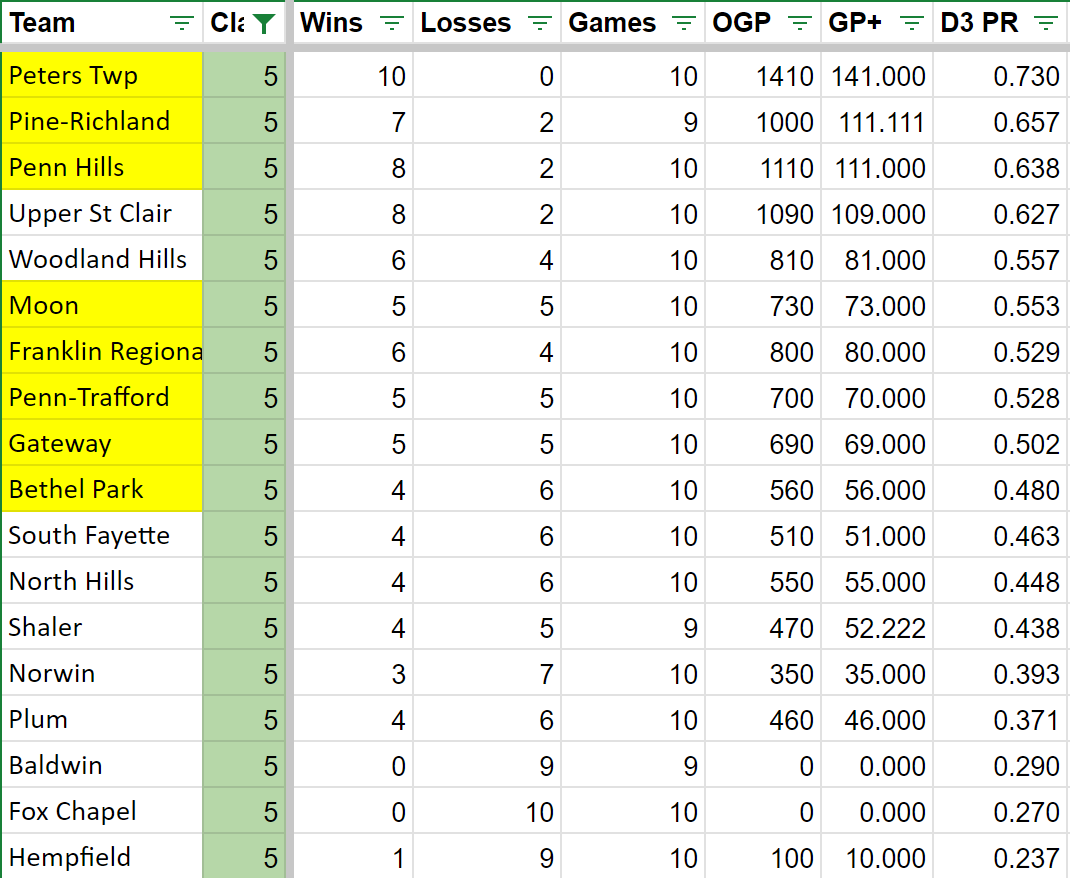 Other Power Ranking formulas exist around different districts in the state. The WPIAL could also create their own formula based on how they want to value different factors such as opponents classification, opponent wins, and even margins of victory. On last week’s WPIAL Blitz Show, I debuted a Statewide version of a Power Rankings formula that I developed taking all three of those above-referenced factors into consideration. All that said, I fully understand that moving to a Power Rankings formula to determine playoff qualifiers would be a massive culture shift in the WPIAL. The last time playoff qualifiers were determined by a formula was over 50 years ago when Gardner Points determined if the top team was awarded a championship or if two teams would play for a title.
Other Power Ranking formulas exist around different districts in the state. The WPIAL could also create their own formula based on how they want to value different factors such as opponents classification, opponent wins, and even margins of victory. On last week’s WPIAL Blitz Show, I debuted a Statewide version of a Power Rankings formula that I developed taking all three of those above-referenced factors into consideration. All that said, I fully understand that moving to a Power Rankings formula to determine playoff qualifiers would be a massive culture shift in the WPIAL. The last time playoff qualifiers were determined by a formula was over 50 years ago when Gardner Points determined if the top team was awarded a championship or if two teams would play for a title.
Conclusion
In conclusion, with statewide realignment coming this winter, the WPIAL will have their biennial opportunity to make changes to the structure conferences and the playoffs. I used 5A as the example here because it is fresh in everyone’s mind given the fact that Upper St Clair missed the playoffs with an 8-2 overall record. That said, any of the above-referenced options could be used in any classification moving forward. (And in full disclosure, all of the formulas I mentioned I have run for every team in the WPIAL and am happy to share the data with anyone who would like to see it, just shoot me a DM on Twitter!) To the credit of the WPIAL, they have made some significant improvements in scheduling and in playoff qualification (the formula adopted in 2020 with a ratio of playoff qualifiers to number of teams in a conference is very good!) Unfortunately, the formula does not apply to 5A because of the PIAA’s change to back up the WPIAL champion’s entrant into the state bracket. There are a lot of moving pieces heading into this realignment season, but the WPIAL has the opportunity to consider a variety of changes (even as small as allowing more than one team from a conference to earn a Wild Card) during this offseason.



